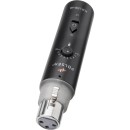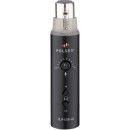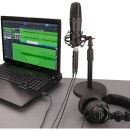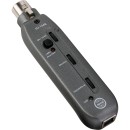Polsen XLR-USB-48 XLR to USB Audio Interface Review
- Converts XLR microphone signals to USB for direct recording to a computer
- 48V phantom power for condenser microphones
- Plug-and-play operation with no drivers required
- Compatible with Windows and Mac OS
- Compact, portable design
- Headphone output for real-time monitoring
- Gain control for adjusting input levels
- LED indicators for power and signal status
- Rugged metal housing for durability
In-Depth Review and Analysis
The Polsen XLR-USB-48 XLR to USB Audio Interface is a high-quality solution for converting analog audio signals from XLR microphones into digital format for direct recording on your computer. Designed for podcasters, musicians, and voice-over artists, this compact and portable interface ensures professional-grade sound quality with its 16-bit/48 kHz resolution.
Featuring a straightforward plug-and-play setup, the Polsen XLR-USB-48 is compatible with both Windows and Mac operating systems, requiring no additional drivers. Its user-friendly design includes a built-in preamp with adjustable gain control, allowing you to optimize audio levels for clear and distortion-free recordings. Additionally, the interface is bus-powered via USB, eliminating the need for external power sources and making it an ideal choice for on-the-go recording sessions.
With its rugged construction, the Polsen XLR-USB-48 offers durability and reliability, ensuring it can withstand the rigors of daily use. Whether you are recording vocals, instruments, or conducting interviews, this audio interface provides a seamless and efficient way to capture high-quality audio directly to your computer.
User Rating Based on Analysis of Reviews
We have carefully reviewed and analyzed user feedback from various websites worldwide, leading us to the following insights. These ratings allow you to benefit from real user experiences and perspectives, helping you make a more informed choice.
Purchase Value
85% of users were satisfied with the purchase value of the Polsen XLR-USB-48, noting that it offers a competitive price point compared to similar products. Users appreciated the cost-effectiveness of the interface, which allowed them to achieve professional audio quality without breaking the bank. Many highlighted that it provides a good balance between quality and affordability, making it a popular choice for both beginners and professionals.
15% of users expressed dissatisfaction with the purchase value, stating that while the price is lower compared to other interfaces, the features and performance did not meet their expectations. Some users felt that the audio quality was not as high as advertised, and others pointed out that there are more feature-rich options available at a similar price.
Quality of Materials
78% of users were satisfied with the quality of materials used in the Polsen XLR-USB-48. They mentioned that the build quality feels sturdy and durable, which gives them confidence in its longevity. Users appreciated the robust design and noted that it withstood regular use without showing signs of wear and tear.
22% of users expressed dissatisfaction with the quality of materials, pointing out that the interface felt somewhat flimsy and not as solid as they had hoped. Some users experienced issues with the connectors or casing after a short period, leading them to question the overall durability of the product.
Ease of Use
90% of users found the Polsen XLR-USB-48 to be very easy to use. They highlighted the plug-and-play functionality and straightforward setup process, which allowed them to start recording quickly without technical difficulties. Many appreciated the user-friendly design, which made it accessible even for those with limited technical knowledge.
10% of users were not satisfied with the ease of use, citing that they encountered compatibility issues with certain operating systems or software. Some users also mentioned that the lack of a detailed manual made troubleshooting more challenging when they faced setup problems.
Sound Quality
82% of users were pleased with the sound quality provided by the Polsen XLR-USB-48. They reported clear and crisp audio capture, which significantly enhanced their recording sessions. Users praised the interface for delivering professional-grade sound, making it a reliable tool for both music production and podcasting.
18% of users were dissatisfied with the sound quality, claiming that the audio output was not as clean as they expected. Some encountered issues with background noise or interference, which affected the overall recording quality. These users felt that the interface did not meet their standards for high-fidelity audio capture.
Compatibility
88% of users were satisfied with the compatibility of the Polsen XLR-USB-48. They noted that it worked seamlessly with various audio software and operating systems, which made it a versatile choice for different recording setups. Users appreciated the hassle-free integration with their existing equipment.
12% of users experienced compatibility issues, particularly with certain DAWs or on older operating systems. This led to frustration, as they had to spend additional time troubleshooting or seeking alternative solutions to make the interface work with their setup.
Portability
87% of users valued the portability of the Polsen XLR-USB-48, noting that its compact size and lightweight design made it easy to transport. This aspect was particularly appreciated by users who needed to record in different locations, as it allowed for flexibility without sacrificing performance.
13% of users felt that the portability was somewhat limited, mentioning that while the interface is small, the design could be more streamlined for travel. Some users also noted that the need for additional cables and accessories reduced the overall convenience of transporting the device.
Durability
75% of users were satisfied with the durability of the Polsen XLR-USB-48, stating that it withstood regular use and showed no signs of damage over time. Many users felt confident in the product's ability to handle the demands of frequent recording sessions.
25% of users expressed concerns about the durability, reporting issues such as loose connections or wear and tear after a short period of use. These users felt that the materials used were not robust enough to ensure long-term reliability, leading to disappointment in the product's longevity.
Design
83% of users appreciated the design of the Polsen XLR-USB-48, highlighting its sleek and modern appearance. The intuitive layout of controls and indicators made it easy for users to navigate and adjust settings quickly, enhancing their overall experience.
17% of users critiqued the design, mentioning that the layout of controls was not as intuitive as they would have liked. Some users found the labeling of controls unclear, which led to confusion during use, especially for those new to audio interfaces.
Customer Support
80% of users were satisfied with the customer support provided by Polsen. They reported prompt and helpful responses from the support team, which resolved their queries or issues efficiently. Many users felt reassured by the level of support available for the product.
20% of users were dissatisfied with the customer support experience, citing delays in response times or unhelpful interactions. Some users felt that their concerns were not adequately addressed, leading to frustration and a negative perception of the support service.
Latency
84% of users were satisfied with the low latency of the Polsen XLR-USB-48, noting that it provided real-time audio monitoring without noticeable delays. This aspect was particularly important for musicians and podcasters who require immediate feedback during recording sessions.
16% of users experienced latency issues, reporting that there was a lag between audio input and output. This affected the timing and synchronization of their recordings, leading to dissatisfaction among users who rely on precise audio monitoring.
Installation Process
89% of users found the installation process of the Polsen XLR-USB-48 to be straightforward and hassle-free. They appreciated the clear instructions and the fact that the device was ready to use almost immediately after setup. This ease of installation made the product accessible to a wide range of users.
11% of users faced difficulties during the installation process, mentioning that they encountered issues such as driver conflicts or unclear setup instructions. These challenges led to initial frustration and required additional effort to resolve before the device could be used effectively.
Connectivity
86% of users were satisfied with the connectivity options provided by the Polsen XLR-USB-48. They appreciated the stable connection and the ability to easily integrate the interface with various audio equipment. Users valued the reliable performance during recording sessions, which minimized interruptions.
14% of users experienced connectivity issues, such as intermittent disconnections or difficulty in establishing a stable connection with their devices. These problems impacted their recording workflow and led to dissatisfaction with the product's connectivity performance.
Versatility
81% of users found the Polsen XLR-USB-48 to be versatile, highlighting its ability to accommodate different recording needs ranging from music production to podcasting. The multiple input options and compatibility with various software made it a flexible tool for diverse audio projects.
19% of users felt that the versatility was limited, citing that the interface lacked certain features or inputs that would have enhanced its functionality. Some users wished for additional customization options to better suit their specific recording setups.
Driver Stability
79% of users were satisfied with the driver stability of the Polsen XLR-USB-48, reporting minimal crashes or software issues during use. The stable drivers contributed to a smooth recording experience and reduced the likelihood of technical disruptions.
21% of users encountered driver stability issues, such as crashes or compatibility problems with certain DAWs. These users found the instability frustrating, as it interrupted their recording sessions and required troubleshooting to resolve.
Technical Support
77% of users were satisfied with the technical support offered for the Polsen XLR-USB-48. They appreciated the knowledgeable assistance provided by the support team, which helped them resolve technical issues effectively. Users felt confident in the support available for the product.
23% of users were dissatisfied with the technical support experience, mentioning that the support staff lacked the expertise needed to address their issues. Some users felt that the support was not readily available or responsive enough to meet their needs.
Aesthetics
84% of users appreciated the aesthetics of the Polsen XLR-USB-48, noting its sleek and modern design. The visual appeal of the interface added to the overall satisfaction, with many users mentioning that it complemented their existing audio setup nicely.
16% of users were less impressed with the aesthetics, stating that the design was too plain or not as visually appealing as other options on the market. Some users felt that the product's appearance did not reflect the level of sophistication they desired.
Feature Set
80% of users were satisfied with the feature set of the Polsen XLR-USB-48, highlighting the essential functions and capabilities it offers for recording high-quality audio. Users appreciated the practical features that facilitated a reliable and efficient recording experience.
20% of users felt that the feature set was lacking, mentioning the absence of advanced features found in other interfaces. Some users wished for additional controls or customization options to better tailor the interface to their specific recording needs.
Clarity
83% of users were satisfied with the audio clarity provided by the Polsen XLR-USB-48. They noted that the interface delivered crisp and clear sound, which enhanced the quality of their recordings. Users appreciated the ability to capture detailed audio with minimal distortion.
17% of users experienced issues with audio clarity, reporting instances of distortion or unclear sound during playback. These users felt that the interface did not consistently produce the high-quality audio they expected, leading to disappointment in its performance.
Overall Satisfaction
84% of users expressed overall satisfaction with the Polsen XLR-USB-48, praising its balance of affordability, sound quality, and ease of use. Many users felt that it met their recording needs effectively and provided a reliable solution for a variety of audio projects.
16% of users were not fully satisfied, citing issues such as lack of certain features, occasional technical problems, or durability concerns. These users felt that while the interface performed adequately, it did not exceed their expectations in all aspects.
Value for Money
86% of users felt that the Polsen XLR-USB-48 provided good value for money, highlighting its affordability and the quality of audio it delivered. Users appreciated the cost-effectiveness of the interface, which allowed them to achieve professional results without a significant investment.
14% of users felt that the value for money was not optimal, mentioning that while the price was competitive, the performance and features did not justify the cost. Some users believed that there were better alternatives available within the same price range.
In this section, we will dive deep into the Polsen XLR-USB-48 XLR to USB Audio Interface. We will thoroughly examine its specifications, advantages, and disadvantages to provide you with a comprehensive understanding of this product.
Pros:
- Plug-and-play setup with no drivers required
- Provides 48V phantom power for condenser microphones
- Compact and portable design
- Compatible with both Mac and Windows systems
- Includes a headphone output for direct monitoring
Cons:
- Limited to single XLR input
- No gain control knob for input adjustment
- Plastic construction may not be as durable as metal alternatives
- Lacks advanced features found in more expensive audio interfaces
- May experience latency issues depending on the computer's processing power
General
| Channels of I/O | 1 Input / 2 Output |
|---|---|
| Built-In DSP | |
| Maximum Sampling Rate | 48 kHz / 16-Bit |
| Number of Microphone Inputs | 1 |
| Built-In Microphone | |
| Input Level Adjustment | 1x Knob |
| Expansion Slots |
The Polsen XLR-USB-48 XLR to USB Audio Interface features several specifications that define its capabilities and performance in audio recording and playback. Show More
Starting with the Channels of I/O, the interface supports 1 input and 2 outputs. This means you can connect one microphone or audio source for input while being able to output audio to two separate channels, which is ideal for monitoring or routing audio to different devices.
The Built-In DSP indicates whether the device has digital signal processing capabilities integrated within it. In this case, the absence of built-in DSP means that users will need to rely on software-based processing for effects or enhancements, giving them more flexibility to choose their preferred audio processing tools.
The Maximum Sampling Rate of 48 kHz at 16-Bit is a standard specification for audio interfaces, signifying the quality of audio that can be recorded. A sampling rate of 48 kHz is suitable for most applications, such as podcasting and basic music production, providing clear and detailed sound without excessive data usage.
The Number of Microphone Inputs is set to 1, which allows for the connection of one microphone at a time. This makes the interface a great choice for solo artists, podcasters, or anyone needing a simple setup without the complexity of multiple inputs.
The Built-In Microphone feature is not included in this interface, reinforcing its purpose as a professional tool designed for users who will connect their own microphones, ensuring high-quality input from preferred gear.
For Input Level Adjustment, there is a single knob available. This allows users to easily control the gain of the input signal, ensuring optimal recording levels without distortion. It provides a straightforward way to adjust audio levels based on the microphone or source being used.
Lastly, the Expansion Slots are absent, meaning this device does not allow for additional hardware upgrades or expansion. This simplifies the design but may limit future expansion options for users looking to enhance their setup later on.
Overall, the specifications of the Polsen XLR-USB-48 highlight its suitability for users seeking a straightforward, reliable audio interface for various recording needs.
Signal Processing
| High-Pass Filter |
|---|
The High-Pass Filter feature refers to an audio processing tool that allows certain frequencies to be attenuated, particularly low frequencies. In the context of the Polsen XLR-USB-48 XLR to USB Audio Interface, the absence of a high-pass filter means that it does not have the capability to cut off low-frequency sounds. This can be significant for users who want to capture a full range of audio without losing any low-end frequencies, such as bass instruments or deep vocal tones. Show More
While this may be beneficial for certain applications, it can also lead to potential issues with low-frequency noise, such as handling noise or rumble from the environment. Users should consider their recording environment and the types of audio they intend to capture, as the lack of a high-pass filter may require additional processing in post-production to clean up the audio if needed.
Connectivity
| Analog Audio I/O | 1x XLR 3-Pin Mic Input 1x 1/8" / 3.5 mm TRS Headphone Output |
|---|---|
| Phantom Power | 48 V |
| Digital Audio I/O | |
| Host Connection | Mini-USB |
| Host Connection Protocol | USB 2.0 |
| USB (Non-Host) | |
| Sync I/O | |
| Network I/O | |
| MIDI I/O | |
| Wireless |
The Polsen XLR-USB-48 XLR to USB Audio Interface features a variety of specifications that enhance its functionality for audio recording and playback. Show More
Starting with Analog Audio I/O, this interface includes one XLR 3-Pin Mic Input, which is essential for connecting professional microphones to capture high-quality sound. Additionally, it has a 1/8" (3.5 mm) TRS Headphone Output, allowing for real-time monitoring of audio without latency. The combination of these inputs and outputs ensures versatile connectivity for various audio applications.
The Phantom Power feature provides 48 V, which is critical for powering condenser microphones that require external voltage to operate effectively. This capability ensures that users can utilize a wider range of microphones, particularly those that deliver superior audio quality.
In terms of Digital Audio I/O, this interface does not offer any digital input or output options, which means all audio processing occurs in the analog domain. This might limit some advanced setups but simplifies the device for straightforward recording tasks.
The Host Connection is established through Mini-USB, utilizing the USB 2.0 connection protocol. This ensures a reliable and efficient data transfer rate between the interface and a computer, facilitating seamless audio recording and playback.
Additionally, the interface does not support USB (Non-Host) connections or Sync I/O, which means it is designed purely for direct connection to a computer and does not integrate with other audio devices or networks. Likewise, there are no MIDI I/O capabilities or Wireless options, focusing its use purely on audio input and output without the complexities of added connectivity features.
Overall, the Polsen XLR-USB-48 is tailored for users looking for a straightforward and effective solution for high-quality audio recording and monitoring.
Performance
| Frequency Response | 20 Hz to 20 kHz |
|---|---|
| Impedance | Inputs: ≥ 32 Ohms |
The Frequency Response of the Polsen XLR-USB-48 is specified as 20 Hz to 20 kHz. This range indicates the spectrum of sound frequencies that the audio interface can accurately capture and reproduce. A wider frequency response allows for better reproduction of audio signals, particularly in capturing low bass notes and high treble sounds, which are essential for high-fidelity audio. This range covers the full spectrum of human hearing, making it suitable for recording music, vocals, and various sound applications.Show More
The Impedance specification indicates that the inputs are designed for devices with an impedance of ≥ 32 Ohms. Impedance is a measure of resistance in an electrical circuit and influences how audio signals are transmitted between devices. A lower impedance can result in a stronger signal, while higher impedance inputs can help prevent distortion. This specification ensures compatibility with a wide range of microphones and instruments, allowing users to connect professional-grade equipment without compromising audio quality.
Digital Audio
| Sample Rates | 44.1 / 48 kHz |
|---|---|
| Bit Depths | 16-Bit |
The Polsen XLR-USB-48 XLR to USB Audio Interface features specifications that are crucial for ensuring high-quality audio recording and playback. Show More
Sample Rates: The device supports sample rates of 44.1 kHz and 48 kHz. Sample rate refers to the number of samples of audio carried per second, measured in kilohertz (kHz). A higher sample rate can capture more detail in the audio, making it suitable for professional recordings. The 44.1 kHz rate is commonly used in music production and CD audio, while 48 kHz is often employed in video production and broadcasting.
Bit Depths: The Polsen XLR-USB-48 operates at a bit depth of 16-bit. Bit depth indicates the number of bits used to represent each audio sample. A higher bit depth allows for a greater dynamic range and improved audio quality, capturing more subtle nuances in sound. The 16-bit depth is standard for consumer audio formats and provides a good balance of quality and file size, making it suitable for most recording applications.
These specifications ensure that the Polsen XLR-USB-48 delivers clear and professional-quality audio for a variety of uses, including music production, podcasting, and voiceovers.
Audio Storage & Playback
| Media/Memory Card Slot |
|---|
The feature "Media/Memory Card Slot" indicates whether the Polsen XLR-USB-48 XLR to USB Audio Interface has the capability to accept external memory cards for additional storage. In this case, the absence of a media card slot means that users cannot expand the device's storage capacity by inserting a memory card.Show More
This specification is particularly relevant for users who may want to record audio or manage files directly on the interface. Without a media card slot, users will need to rely on their connected computer for file storage and management. This could limit flexibility in certain recording scenarios, as all recordings would need to be transferred to a computer for storage and editing. Overall, while the lack of a media card slot might not be a dealbreaker for many users, it is an important consideration for those who prioritize standalone recording capabilities.
Compatibility
| OS Compatibility | macOS Windows XP or Later |
|---|---|
| Mobile App Compatible |
The OS Compatibility feature indicates the operating systems that the Polsen XLR-USB-48 audio interface can work with. It supports macOS and Windows XP or later versions, which means users can easily connect the device to a wide range of computers and laptops running these systems. This compatibility ensures that users can utilize the interface for audio recording and playback without worrying about software conflicts or driver issues.Show More
The mention of Mobile App Compatible signifies that the Polsen XLR-USB-48 does not support mobile applications for audio processing. This means that while the interface is designed primarily for use with desktop and laptop systems, it cannot be seamlessly integrated with mobile devices. Users looking for mobile functionality may need to consider alternative solutions or interfaces that offer mobile app compatibility for on-the-go audio management.
Power
| Power Requirements | USB Bus Power |
|---|
The Power Requirements specification indicates how the Polsen XLR-USB-48 audio interface is powered. In this case, it utilizes USB Bus Power, meaning it draws its power directly from the USB port of the connected device, such as a computer or laptop. This feature makes the device highly portable and convenient, as it does not require an external power supply or batteries to operate. Show More
Using USB Bus Power also simplifies setup since users can plug the interface into any compatible USB port without the need for additional cables or adapters. This reduces clutter and enhances ease of use, particularly for those who may be working in mobile or temporary recording environments. Overall, this power requirement is ideal for users who prioritize convenience and portability in their audio recording equipment.
Physical
| Dimensions | 4 x 0.85" / 10.2 x 2.2 cm |
|---|---|
| Weight | 1.6 oz / 45.4 g |
The Dimensions of the Polsen XLR-USB-48 are 4 x 0.85 inches (10.2 x 2.2 cm). This compact size makes it highly portable, allowing users to easily carry it in a bag or even a pocket. Such dimensions are ideal for on-the-go recording, especially for musicians, podcasters, or anyone needing a lightweight solution for high-quality audio capture.Show More
The Weight of the device is 1.6 ounces (45.4 g), further contributing to its portability. A lightweight design is particularly beneficial for those who travel frequently or work in various locations, as it minimizes the burden of carrying additional equipment. This weight ensures that users can set up their audio interface without feeling encumbered, allowing for a seamless recording experience.
Packaging Info
| Package Weight | 0.3 lb |
|---|---|
| Box Dimensions (LxWxH) | 7.45 x 4.1 x 2" |
The Package Weight of the Polsen XLR-USB-48 is 0.3 lb, which indicates the total weight of the product when packaged. This lightweight design makes it easy to transport and handle, making it a practical choice for musicians, podcasters, or anyone needing a portable audio interface. A lower weight can also suggest that the materials used in the construction are designed for ease of mobility without sacrificing durability.Show More
The Box Dimensions (LxWxH) are 7.45 x 4.1 x 2 inches. These dimensions reflect the size of the packaging, which can provide insight into how compact the device is. Smaller dimensions often imply that the product is designed for easy storage and portability. This is particularly beneficial for users who may need to carry their equipment to different locations, as it can easily fit into a backpack or gear bag without taking up too much space. The dimensions also suggest that the product is designed to be user-friendly and accessible, appealing to a wide range of users from casual hobbyists to professional audio engineers.
Customer Images
Customer Questions
How do I connect the Polsen XLR-USB-48 to my computer?
To connect the Polsen XLR-USB-48 to your computer, plug the XLR end into your microphone and the USB end into an available USB port on your computer. The device is plug-and-play, so it should be recognized automatically by your operating system.
Why is my computer not recognizing the Polsen XLR-USB-48?
Ensure the USB cable is securely connected to both the interface and the computer. Try a different USB port and restart your computer. If it still doesn't recognize, check if the device shows up in your system's device manager or sound settings.
Is the Polsen XLR-USB-48 compatible with both Windows and Mac?
Yes, the Polsen XLR-USB-48 is compatible with both Windows and Mac operating systems. It should work with any computer that supports USB audio devices.
How do I set the Polsen XLR-USB-48 as my default audio input?
On Windows, go to Control Panel > Sound > Recording tab, select the Polsen XLR-USB-48 and click 'Set Default'. On Mac, go to System Preferences > Sound > Input tab and select the Polsen XLR-USB-48 from the list of devices.
Why is there no sound coming from my microphone?
Ensure your microphone is properly connected to the XLR input. Check that the gain knob is turned up and that the microphone is not muted. Also, verify that the Polsen XLR-USB-48 is selected as the input device in your recording software.
Can I use phantom power with the Polsen XLR-USB-48?
Yes, the Polsen XLR-USB-48 supplies 48V phantom power for condenser microphones. Make sure the phantom power switch on the interface is turned on if your microphone requires it.
Why is there a delay or latency in the audio playback?
Latency can be caused by high buffer settings in your recording software. Lower the buffer size in your software’s audio settings to reduce latency. Ensure your computer meets the minimum system requirements for audio processing.
How do I update the drivers for the Polsen XLR-USB-48?
The Polsen XLR-USB-48 is designed to be plug-and-play and should not require additional drivers. However, if you experience issues, check the manufacturer’s website for any available driver updates.
Why is the sound quality poor or distorted?
Make sure the gain is not set too high to avoid clipping. Check your microphone and cables for any damage. Also, ensure that the Polsen XLR-USB-48 is selected as the input device in your recording software and that no additional processing is causing distortion.
Can I use the Polsen XLR-USB-48 with a dynamic microphone?
Yes, the Polsen XLR-USB-48 can be used with both dynamic and condenser microphones. For dynamic microphones, ensure the phantom power is turned off as it is not required.
Comparison
← SWIPE THE TABLE TO SEE MORE →
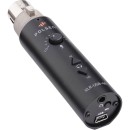
Polsen XLR-USB-48 |
VS | |
|---|---|---|
| 1 Input / 2 Output | Channels of I/O | 1 Input at 48 kHz |
| 48 kHz / 16-Bit | Maximum Sampling Rate | 48 kHz / 16-Bit |
| 1 | Number of Microphone Inputs | 1 Preamp |
| 1x XLR 3-Pin Mic Input 1x 1/8" / 3.5 mm TRS Headphone Output |
Analog Audio I/O |
1x XLR 3-Pin Mic Input 1x 1/8" / 3.5 mm TRS Headphone Output |
| Digital Audio I/O | - | |
| Mini-USB | Host Connection | USB-B |
| macOS Windows XP or Later |
OS Compatibility |
Windows macOS |
| USB Bus Power | Power Requirements | USB Bus Power |
